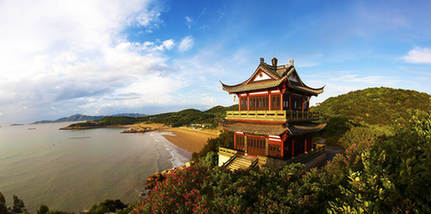Chaoyang Pavilion on Putuo Mountain.
Zhoushan Archipelago: Buddhist Paradise Between Sea and Sky
By WU MEILING
LEGEND has it that, around 2,000 years ago, a Japanese monk named Hui’e made a pilgrimage to Wutai Mountain, a sacred Buddhist site in Shanxi Province. There he obtained a statue of Guanyin, Goddess of Mercy, with the intention of taking the figure back to Japan. After setting sail to a gentle breeze and fine ripples, a raging storm erupted as the vessel approached Zhoushan Archipelago in present-day Zhejiang Province. After the tempest subsided, a vast floating carpet of lotus blossoms blocked the ship’s path. Hui’e took this as a sign that the image of the Goddess Guanyin was unwilling to leave China. Out of respect for her wishes, he took the statue to the nearest island and placed it in Chaoyin Cave at the foot of Putuo Mountain. A local resident surnamed Zhang who had witnessed the extraordinary event offered his house as a temple to Guanyin. He named it “Temple to the Goddess of Mercy, Who Declines to Leave.” Today, Putuo Mountain is one of China’s “Four sacred mountains of Buddhism,” and Zhoushan Archipelago is a state-level new district, known as Buddhist Paradise on the Sea.
 |
|
|
Zhoushan Archipelago is actually an extension of the Tiantai Mountain Ranges in east Zhejiang Province. Its higher peaks became islands 8,000 to 10,000 years ago when the sea level rose and submerged the lower mountains. Mount Putuo – Sanskrit for “beautiful white flower” – is one of the biggest islands. Celebrated for its beautiful scenery, the mountain has more than 10 natural scenic spots that feature grotesquely shaped stones, secluded caves, lush forests, sandy beaches and impressive reefs. There is an ancient Chinese saying that Hangzhou’s West Lake offers the most beautiful lake and mountain views and Putuo Mountain the most breathtaking mountain and sea vista. The island’s Buddhist legacy is manifest in the island’s architecture. The Tang Dynasty (618-907) when Buddhism was at its height in China, saw the building of three major temples, 88 small ones and 128 dwellings on Putuo.
The journey to Mount Dai, one of China’s 12 island counties, takes about 40 minutes by ship from Zhoushan’s main island. The Records of the Grand Historian tell of how Emperor Qin Shihuang charged the alchemist Xu Fu with voyaging to distant islands with 3,000 children who would pick herbs with which to make the elixir of life. Children were considered suitable for this task as they were pure in mind and body and their small hands would not bruise the plants. The party landed on Penglai Fairyland (today’s Mount Dai), so named during the Tang Dynasty, and one of China’s holy mountains.
The sight I found most impressive on Mount Dai was its 12,000-odd mu (1 mu equals 0.067 hectares) salt pan. Under bright sunshine, crystallized sodium chloride at the base glistens while salt crystals on the upper layer emit a silvery sheen. I arrived at sunset to the glorious sight of glittering salt columns against a deep blue sky.
Mount Dai Island occupies less than 330 square kilometers, but is nonetheless site of 10 ocean-themed museums. They include the China Typhoon Museum, China Marine Fishery Museum, China Salt Industry Museum, China Lighthouse Museum, China Coast Defense Museum and China Reef Museum. All give insight into China’s sea industry and culture.
Farther away are the Shengsi Isles. The perfect retreat from busy city life, their alternating green and blue waters reflect varying ocean depths. From afar, these changing colors lend the islets a magical ethos.
Scattered over 8,738 square kilometers of sea, the Shengsi Isles are also known as “Tiny Town.” Out of the total 400 isles, 16 indeed house miniature towns that are home to a total population of 76,000.
The Shengsi Isles are in a supreme location southeast of Shanghai, connected to its Luchao Port via Donghai Bridge. During the two years since the bridge opened to traffic, growing numbers of Shanghai residents have traveled to the isles at weekends and on holidays to enjoy their beach and mountain scenery.
Shengshan Isle, a main aspect of the Shengsi Isles scenic area, is an authentic fishing village deeply entrenched in ocean culture. Pictures painted by local fishermen that express their love for the ocean and the world beyond hang on the walls of most homes. A climb to a high vantage point reveals an enchanting panorama of the island and its colorful houses set against the backdrop of blue sky and green sea.

